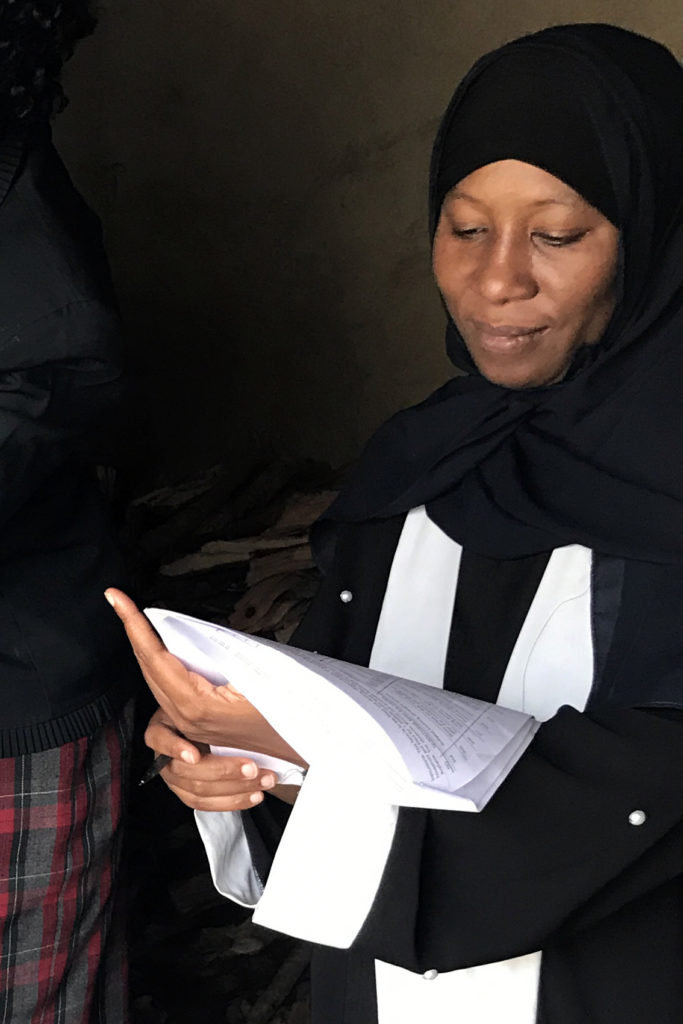Luminare: Field Testing Solutions to Anthropometry Data Collection in Nigeria

© 2018 Hanna Useem/ICF
This blog post is part of Luminare, our new blog series exploring innovative solutions to data collection, quality assurance, biomarker measurement, data use, and further analysis. This is the first post in the series that focuses on innovations to improve the quality of anthropometry data.
Anthropometry, the measurement of the human body, gives a snapshot of the malnutrition situation in a country. Yet, the collection of accurate height and weight measurements, especially for young children, is difficult during data collection. To address this challenge, The DHS Program has tested new innovations to enhance the quality of the anthropometry data in the 2018 Nigeria Demographic and Health Survey (NDHS).
The 2018 NDHS is the sixth DHS survey conducted in Nigeria. The National Population Commission (NPC), in collaboration with the National Malaria Elimination Programme (NMEP) of the Federal Ministry of Health (FMOH), implemented the survey. Thirty-seven field teams closely monitored by coordinators and quality controllers collected data from August 14, 2018, to December 29, 2018. Each field team included a supervisor, field editor, two male interviewers, three female interviewers, and a biomarker team consisting of a lab scientist and nurse.
Introducing a Biomarker Checklist to strengthen supervision

© 2018 Sorrel Namaste/ICF
The DHS Program has developed a Biomarker Checklist to assess the performance of and provide feedback to field staff. The checklist includes a core set of tasks required to collect biomarker data. Each task is a crucial action that, if missed, can result in poor quality data. The Biomarker Checklist is administered by supervisors and coordinators during collection of biomarkers in households.
The Biomarker Checklist was tested during the 2018 NDHS pre-test and biomarker main training using a mixed-method design which included administering anonymous questionnaires and conducting key informant interviews with the supervisory staff who used the checklist to assess its’ viability and usefulness. Feedback on the Biomarker Checklist was positive, so the Biomarker Checklist was used during the 2018 NDHS data collection. A Biomarker Checklist will be publicly available at a later date.
“it [Biomarker Checklist] has helped a lot because you are able to monitor what the biomarkers are doing so [you] can actually give corrective action”
Reducing errors while still in the field through re-measurement of children
The shift from paper questionnaires to a CAPI-based data collection approach provides an opportunity to easily identify children who may have been mismeasured and return to the household to measure these children again. To identify children with incorrect measurements requires performing a complicated calculation – a child’s body measurements are compared against a healthy population by transforming their measurements into anthropometry Z-scores. Extreme measurement results are then detected by calculating anthropometry Z-scores and flagging cases with higher or lower Z-scores than expected. The DHS Program has developed a program to automatically calculate anthropometry Z-scores and flag extreme cases in the CAPI system. A user-friendly interface on the tablet produces a report with the children who need to be re-measured.
The DHS Program relies on field check tables that are run periodically during data collection. While an important data quality tool, a major limitation of the field check tables is that enough data need to accumulate before problems can be identified. At that point, the information can only be used to improve collection of data moving forward; these corrections do not fix data previously collected. The real-time ability to re-measure children while still in the field is a major step forward and can easily be applied to other CAPI surveys.
Re-measuring anthropometry in a random subsample of children

A random re-measurement of height and weight in a subsample of children was also piloted in Nigeria. The DHS Program has developed a CAPI program that randomly selects one household in each cluster for the biomarker team to revisit. The program then compares differences between measurements and reports precision, or how close the first measurement is to the second measurement, as acceptable or unacceptable.
The aim is measurements will be of better quality as a result of instituting random re-measurement. The biomarker team may be more careful and not rush measurements if they know poor measurements will be exposed. The data produced on precision can be used as a motivational tool for biomarker teams and provide an opportunity to identify and re-train in cases where there is a high degree of discrepancy between measurements. Precision estimates will also help better assess data quality post-data collection.
Results
A review of the anthropometry data from the 2018 NDHS indicates it meets data quality targets. Results from the 2018 NDHS Key Indicators Report (KIR) show that 37% of children under 5 are stunted. Stunting generally increases with age, peaking at 47% for children age 24-35 months. Overall, 7% of children under 5 are wasted, while 23% of children are underweight.

Lessons learned in the implementation of the quality assurance activities in Nigeria are being used to conduct similar activities in DHS surveys in other countries.
About the survey

The 2018 NDHS was implemented by the National Population Commission (NPC) in collaboration with the National Malaria Elimination Programme (NMEP) of the Federal Ministry of Health, Nigeria. Funding for the 2018 NDHS was provided by the United States Agency for International Development (USAID), Global Fund, Bill and Melinda Gates Foundation (BMGF), the United Nations Population Fund (UNFPA), and World Health Organization (WHO). ICF provided technical assistance through The DHS Program, a USAID-funded project that provides support and technical assistance in the implementation of population and health surveys in countries worldwide.
Additional information about the 2018 NDHS may be obtained from the headquarters of the National Population Commission (NPC), Plot 2031, Olusegun Obasanjo Way, Zone 7, Wuse, P.M.B. 0281, Abuja, Nigeria (telephone: 234-09-523-9173; fax: 243-09-523-1024; email: info@population.gov.ng; internet: www.population.gov.ng).

